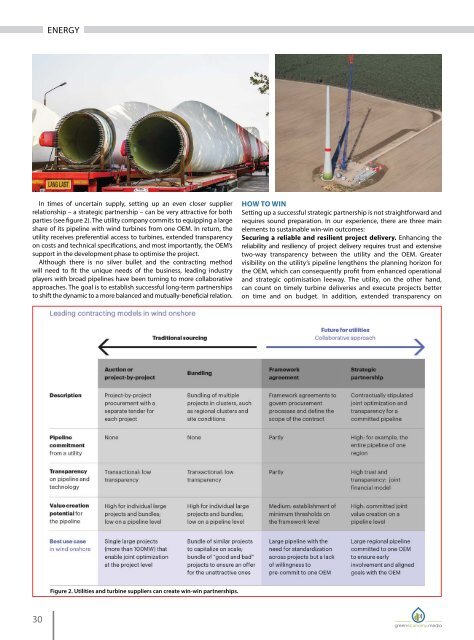Green Economy Journal Issue 57
Create successful ePaper yourself
Turn your PDF publications into a flip-book with our unique Google optimized e-Paper software.
ENERGY<br />
ENERGY<br />
In times of uncertain supply, setting up an even closer supplier<br />
relationship – a strategic partnership – can be very attractive for both<br />
parties (see figure 2). The utility company commits to equipping a large<br />
share of its pipeline with wind turbines from one OEM. In return, the<br />
utility receives preferential access to turbines, extended transparency<br />
on costs and technical specifications, and most importantly, the OEM’s<br />
support in the development phase to optimise the project.<br />
Although there is no silver bullet and the contracting method<br />
will need to fit the unique needs of the business, leading industry<br />
players with broad pipelines have been turning to more collaborative<br />
approaches. The goal is to establish successful long-term partnerships<br />
to shift the dynamic to a more balanced and mutually-beneficial relation.<br />
HOW TO WIN<br />
Setting up a successful strategic partnership is not straightforward and<br />
requires sound preparation. In our experience, there are three main<br />
elements to sustainable win-win outcomes:<br />
Securing a reliable and resilient project delivery. Enhancing the<br />
reliability and resiliency of project delivery requires trust and extensive<br />
two-way transparency between the utility and the OEM. Greater<br />
visibility on the utility’s pipeline lengthens the planning horizon for<br />
the OEM, which can consequently profit from enhanced operational<br />
and strategic optimisation leeway. The utility, on the other hand,<br />
can count on timely turbine deliveries and execute projects better<br />
on time and on budget. In addition, extended transparency on<br />
OEM-proprietary technical data, especially for upcoming turbine<br />
types, can benefit both parties for joint first projects with the new<br />
turbine generation.<br />
Collaboratively optimising projects to enlarge the value pool.<br />
By jointly optimising projects in early development phases, the OEM<br />
and the utility can unlock value pools that would not be achievable<br />
for the utility alone. Tackling the full envelope of cost and yield can<br />
reduce LCOE by up to 30%. Without fair sharing of the additionally<br />
generated value, the OEM would not optimise projects to their<br />
full potential, but only to the point it is profitable for the OEM (for<br />
example, up to a certain threshold value, such as target LCOE).<br />
Important elements of joint optimisation include:<br />
• Comprehensive optimisation of turbine selection and layout<br />
in iterative workshops across the OEM’s and utility’s turbine,<br />
electrical, and civil engineering. Configuration decisions and<br />
power curve customisation are made on a component level,<br />
based on net present value and LCOE impact.<br />
• Transparent, bottom-up planning of operations and maintenance<br />
costs over asset lifetime, leveraging OEM data and best practices.<br />
• Lifetime operations and maintenance cost and yield optimisation,<br />
enabled by access to anonymised turbine data beyond the own<br />
fleet, such as historical failure rates.<br />
Going beyond traditional partnerships. Best-in-class partnerships<br />
go beyond joint LCOE reduction and supply security – pushing the<br />
potential to create value even further.<br />
Successful extended partnerships in the market include:<br />
• Joint M&A activity. Combined market knowledge to identify<br />
opportunities and exclusivity for a first call in M&A opportunities.<br />
• Asset and liability pooling. Pooling assets and liabilities across<br />
projects to enable portfolio-level benefits.<br />
• Joint market-entry strategies. Entering new markets with<br />
combined power and aligned interests.<br />
• Equity stakes. Perfectly aligning long-term incentives, such as<br />
with a joint venture or acquisition of an equity stake in a partner.<br />
THE WAY FORWARD<br />
So how can you find out if closer OEM collaboration and a<br />
partnership approach are the right strategies for you? We suggest<br />
starting with three steps:<br />
• Review your project development approach and identify<br />
the most pressing issues.<br />
• Assess the robustness of your current procurement strategy<br />
and your collaboration model with OEMs.<br />
• Analyse your portfolio fit for a partnership and quantify the<br />
potential joint value creation.<br />
*Article written by Hanjo Arms, partner, Oskar Schmidt, principal and Jan Weber, consultant.<br />
Framework agreements create<br />
value by standardising procurement<br />
processes across projects and by capturing<br />
scale advantages for large pipelines.<br />
Figure 2. Utilities and turbine suppliers can create win-win partnerships.<br />
30<br />
31

















